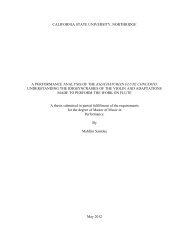2644 - CSUN ScholarWorks - California State University, Northridge
2644 - CSUN ScholarWorks - California State University, Northridge
2644 - CSUN ScholarWorks - California State University, Northridge
Create successful ePaper yourself
Turn your PDF publications into a flip-book with our unique Google optimized e-Paper software.
2736<br />
Journal of Student Research Abstracts · 45<br />
THE ACTIONS OF RENU MULTIPLUS MULTI-PURPOSE SOLUTION ON<br />
B. CEREUS<br />
Bryan James Fang and Steve DeGusta (teacher). John F. Kennedy High School, 6715 Gloria Drive,<br />
Sacramento, CA 95831.<br />
In this investigation, I tried to show if contact lens solution (Renu Multiplus Multi-purpose solution)<br />
inhibits the growth of bacteria (B. cereus). The Renu Multiplus Multi-purpose solution contains the ingredient<br />
Dymed that is supposed to kill microorganisms on contact lenses. B. cereus is grown on agar containing contact<br />
lens solution. I used the pour-plating method to transfer the bacteria to the agar. I wanted no bacteria grown<br />
on the agar when it is incubating. I used twenty-one petri dishes. I used different concentrations for these petri<br />
dishes. I labeled these concentrations as agar #1, 2, 3, 4. Each agar contained different concentrations.# 1 agar<br />
contained 50 ml of water for 1.15 g of nutrient agar. #2 agar contained 5 ml of contact lens solution and 45 rnl<br />
of water for 1.15g of nutrient agar. #3 agar contained 25 rnl of contact lens solution and 25 ml of water for<br />
1.15g of nutrient agar. #4 agar contained 50 ml of contact lens solution for 1.15g of nutrient agar. Five petri<br />
dishes were used for each group of agar. In addition, a single petri dish contained B. cereus grown on agar with<br />
paper filter disks containing contact lens solution. This is called the additional experiment. After this the petri<br />
dishes were incubated at room temperature. My results showed that the contact lens solution is effective in<br />
inhibiting the growth of bacteria. Agar #2, 3, 4 inhibited the growth of bacteria. The paper filter disks containing<br />
contact lens solution in the additional experiment, also showed effectiveness. Around each paper filter<br />
disk (except water) were zones of inhibition.<br />
2737<br />
THE EFFECT OF NEOSPORIN OINTMENT ON ESCHERICHIA COLI.<br />
Matthew Henry Lum and Steve DeGusta (teacher). John F. Kennedy High School, 6715 Gloria Drive,<br />
Sacramento, CA 95831.<br />
In this experiment, I am trying to find out if Neosporin ointment will inhibit the growth of E. coli. Using<br />
aseptic methods, I streaked E. coli on ten petri dishes containing nutrient agar. Five of the petri dishes were<br />
used as the experiment and the remaining five petri dishes were used as the control. In the each experiment<br />
dish, I placed four self-made antibiotic disks in a straight line, evenly spaced from each other. The self-made<br />
antibiotic disks were plain paper disks that were covered with a thin layer of Neosporin ointment. In each control<br />
dish, I placed four plain paper disks in a straight line even spaced from each other. Then all ten dishes were<br />
placed in the incubator. After incubating the ten dishes at 37°C for 24 hours, the results were that 18 out of the<br />
20 experimental antibiotic disks had a zone of inhibition around them and 20 out of the 20 plain control disks<br />
had no zone of inhibition around them. Results indicated that 18 out of the 20 experimental antibiotic disks<br />
inhibited the growth of E. coli, while 20 out of the 20 plain control disks did not inhibit the growth of E. coli.<br />
Therefore, I conclude Neosporin does inhibit the growth of E. coli. After statistical analysis, my p-value was<br />
less than 0.001, so my conclusion was not due to chance.













